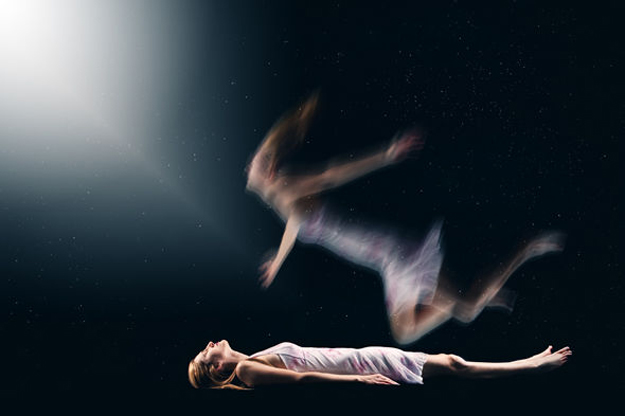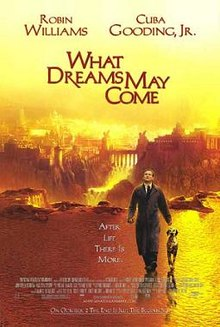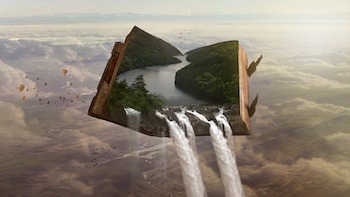Possible Relationship Between Subtle Bodies and Near Death Experiences

“NDE pushes at the limits of medical ideas about the range of human
consciousness and the mind-brain relation.”
This is defined as a world or realm composed of matter which though not visible to physical eyes is nevertheless everywhere present and which interpenetrates the physical matter the senses of the physical body observe and experience. The particles of substance of this realm exist everywhere in free form and possess a variety of characteristics and properties akin to chemical elements of the physical world. These subtle particles are capable of joining together to form coherent and stable objects as well as life forms having distinct components and functions. A certain amount of this subtle substance also makes up the astral or subtle body humans experience dreams in and resides in the same volume as the human body while an individual is awake. The existence of a subtle world composed of a more subtle state or gradation of matter is posited as a fundamental premise of this website. In addition, there is no evidence to suggest this degree of matter ends at the upper limit of the earth's atmosphere. So another basic premise we posit is that it extends into space indefinitely in all directions continuously and with no breaks.


This is a really monumental movie dressed up as entertainment. In subject matter, it scales the Earth, heaven and hell, the heights of human love, the depths of depression, and our lives while alive on earth and after.
Life after death can be heaven or hell depending on the thought habits one cultivates while alive on Earth. Positive or negative; strong or weak, optimistic or pessimistic, kind or angry, full of love or full of bitterness. The main character (Robin Williams) loved art and beauty while alive and consequently his heaven was like living inside of his favorite painting.
He dies in a car crash and is met by an old friend (Cuba Gooding Jr.) almost immediately thereafter who becomes his spirit guide. His guide gently leads him to understand and accept that he has died, yet still exists and is just as conscious as he was while "alive". Part of the spirit guide's initial teaching is that this new environment in which the main character finds himself is thought responsive; and that consequently his thoughts create reality. This is a fundamental premise we students of the subtle world know is true.
I first watched this movie 15 years ago, before I knew anything about the subtle world other than that I had very vivid and interesting dreams. At that time it was one of my favorite movies because of how artful and beautiful it was (it won an Academy Award for Visual Effects) and how genuine and sincere it depicted family relationships. Now I'm blown away by how much the content of this movie aligns with all the things I've learned about life, death, and the Subtle World over the last few years.


In Mexico, the “Day of the Dead” is a day of festive remembrance of family and friends who have passed away. Families typically visit the graveyards where their loved ones are buried and bring pictures of the deceased along with their favorite food, drink, and music. These items are thought to encourage the visit of the deceased one’s spirit from the “land of the dead”. The origins of this cultural tradition are thought be among the Aztec civilization 2,500 – 3,000 years ago (see reference 1 below for more information).
The movie Coco depicts this Mexican festival beautifully and the movie has become mandatory viewing for all young Americans of Mexican descent (trust me on this one).
Miguel is a young boy who desires more than anything else to be a musician. However, he has the bad fortune of being born into a family that has completely shunned music and anything having to do with music for generations. On the day of the dead, Miguel somehow passes into the “land of the dead”, meets several of his ancestors he’s only seen in pictures, explores the history of his family’s relationship to music and fame, helps his family discover the truth behind a terrible incident, and resolves conflicts that have robbed the family of peace for decades.
It is a wonderful story exposing children and adults alike to concepts worth thinking about and discussing.
Not only does the whole country of Mexico believe that people continue their existence after death in a subtler realm, but so do several other cultures like modern Tibetan Buddhists (ref: The Tibetan Book of the Dead), ancient Egyptians (2), the Ancient Mayans (3) and Aztecs (4), modern Hindus (5), Celtics (6), and even several modern American and British authors like the clairvoyants CW Leadbeater (7) and Annie Besant (8). In many cases, the aforementioned peoples and writings give a detailed geography of the other world, outlining various regions of it and describing their qualities. All these people and cultures (except Mexico, oddly enough), say that a person goes there after death and stays there for a time before eventually reincarnating in another body for another round of earthly life. [Sometimes in dreams we really speak to those people who are living in that realm for the time being.]
There are 3 ways to cross over into and have experiences in the “Land of the Dead” (i.e. Subtle Realm):
The “Land of the Dead” is a concept embraced by many different cultures around the world and throughout time. This movie does a great job depicting, in a fun and family-friendly way, what that “place” (realm) might be like.
If you liked this movie, there is another movie that came out a few years earlier that didn’t get as much attention but that is equally enjoyable and beautiful and also centers around the day of the dead and traveling to the land of the dead. It’s called “Book of Life”.
1) https://www.diffen.com/difference/Day_of_the_Dead_vs_Halloween
2) https://en.wikipedia.org/wiki/Ancient_Egyptian_religion#Afterlife
3) https://en.wikipedia.org/wiki/Maya_death_rituals#Beliefs_about_the_afterlife
5) http://www.bbc.co.uk/schools/gcsebitesize/rs/death/hindubeliefrev2.shtml
6) https://www.adf.org/articles/gods-and-spirits/ancestors/afterlife-hero-dead.html

The Reality of Imagination
Science has proven that if a person sits down and imagines themselves in a heated argument, that the exact same centers of the brain are activated as when a person is actually in a heated argument. While the flow of neuron interactions may be different between real and imagined events as this article indicates,:
https://www.livescience.com/49244-imagination-reality-brain-flow-direction.html
...the same neurological networks within the brain are engaged. Indeed, anyone who has found themselves thinking of any kind of emotionally-charged interaction after the fact, can confirm that the exact same emotions that they experienced during the interaction will surface while simply thinking about it. On a similar note, all of the incredible, very real inventions that make our lives so good have been discovered by way of the imagination of the inventor. In both instances, imagination becomes reality.
My experience has been that my consciousness does not differentiate between ‘real’ and ‘imagined’. Both seem to occur with equal reality to my mind. If I think about an upsetting event (real or imagined), I get upset. If I think about playing with my favorite pet, I get all warm and happy inside. So it kinda makes me wonder, when I leave my physical body at night and have experiences in the subtle world (i.e. dreaming), just how real are these experiences? However bizarre the circumstances, however strange the juxtaposition of events or things, my mind perceives and experiences them as being real.
What does that mean for me in a practical sense? After giving this some thought, I think this question is best answered with a question: what do I want in life? Like most people, my answer involves the goal of happiness. So how do I get this happiness in my life?
The way I see it, the quality of my dreams - good or bad - just like the quality of my life in the physical world, depends wholly upon me. When my thoughts tend toward the positive, and I genuinely feel drawn to goodness, be it beauty, truth, benevolence, I will find myself attracted to people, things, and situations that reflect these qualities. On the other hand, if my thoughts are drawn to things such as addictions, hate, or anger, then I find myself being drawn to other people, things, and situations that reflect those qualities. I have been able to actually observe this in my life.
For instance, I used to have a fascination for news stories about people who did crazy stuff while on drugs. I would be browsing the news and find a bizarre headline with a couple of weird pictures that I couldn’t resist clicking on, and I’d read the story and marvel at whatever the story had to offer. Then at night, I would quite often find myself (in my dreams) hanging out with people who were doing drugs. So I tried a thought-experiment - I stopped clicking on and reading stories of that nature. And you guessed it - I stopped having dreams about being around those kinds of folks. In fact, I found myself having a much broader variety of experiences that included some pretty amazing things!
Suddenly my thoughts became far more important than they used to be. And I guess I finally, really accepted that I am “the captain of my own ship” when it comes to what kinds of thoughts I have. If I’m after happiness in the physical or subtle worlds, then I need to go to where I want to be - with my mind. Simple as that.

With peace and serenity in my daily life, my subtle world (or dream) life is very much more pleasant and the colors are more vivid. When I'm irritated, worried, or super distracted in my waking life, my dreams are extremely chaotic and seem to have no rational connection to each other whatsoever and are often quite dark and gloomy. This is all stuff we've talked about before. However...
I've been having more success with meditation lately, and I find it to carry over into my daily living and now I see how it is affecting my dreams as well. When I get meditation "right", I generally feel lighter during the day. I mean that I don't feel so attached to all the things that happen around me and just tend to observe and appreciate things more -weather, nature, people, my health. My mind is more focused and I don't let things pull my attention away from what I'm trying to accomplish.
An interesting question arises: what is MORE real? The things that are happening outside yourself, or the the things that are happening within? The so-called "objective" or the so-called "subjective"? We are human beings having a human life experience. The things that are going on within us -thoughts, emotions, intuitions, desires, etc.- determine our destiny and life path much more than the physical things that surround us, don't they? Two people can go through the exact same material experience; one of them it crushes and depresses him for the rest of his life; the other faces it, deals with it, learns, grows, and becomes a stronger person because of it. What's the difference? The inner nature of the individuals. Isn't that inner nature, then, at least as real as the thing that happened to them?
Maybe our response to things isn't a response, is what I'm trying to say. Maybe we have anger, irritation, or lust as PRE-EXISTING CONDITIONS, embedded in our consciousness first. Maybe that is the reality. It's not that someone cuts us off in traffic and then we get upset; it's that we are upset and then someone switched lanes in front of us. When we're in the subtle world, where the matter is maleable in response to thoughts, those pre-existing conditions materialize as part (or whole) of our subtle world experience.
I believe this is true. And it's about time I begin taking more responsibility for establishing more wholesome and beneficial pre-existing conditions in my consciousness.
Copyright © 2024, SubtleRealm
